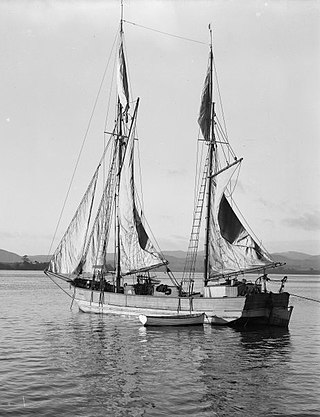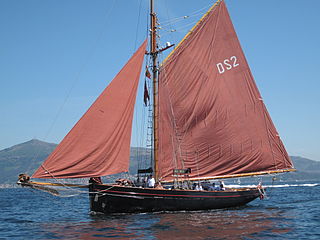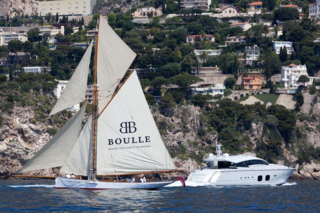
A catboat is a sailboat with a single sail on a single mast set well forward in the bow of a very beamy and (usually) shallow draft hull. Typically they are gaff rigged, though Bermuda rig is also used. Most are fitted with a centreboard, although some have a keel. The hull can be 3.7 to 12.2 metres long with a beam half as wide as the hull length at the waterline. The type is mainly found on that part of the Eastern seaboard of the USA from New Jersey to Massachusetts.

A scow is a smaller type of barge. Some scows are rigged as sailing scows. In the 19th and early 20th centuries, scows carried cargo in coastal waters and inland waterways, having an advantage for navigating shallow water or small harbours. Scows were in common use in the American Great Lakes and other parts of the U.S., Canada, southern England, and New Zealand. In modern times their main purpose is for recreation and racing; there are also garbage scows for aquatic transport of refuse.

Gaff rig is a sailing rig in which the sail is four-cornered, fore-and-aft rigged, controlled at its peak and, usually, its entire head by a spar (pole) called the gaff. Because of the size and shape of the sail, a gaff rig will have running backstays rather than permanent backstays.

Jolie Brise is a gaff-rigged pilot cutter built and launched by the Albert Paumelle Yard in Le Havre in 1913 to a design by Alexandre Pâris. After a short career as a pilot boat, owing to steam replacing sail, she became a fishing boat, a racing yacht and a sail training vessel.

Gipsy Moth IV is a 53 ft (16 m) ketch that Sir Francis Chichester commissioned specifically to sail single-handed around the globe, racing against the times set by the clipper ships of the 19th century.

Polly Woodside is a Belfast-built, three-masted, iron-hulled barque, preserved in Melbourne, Victoria (Australia), and forming the central feature of the South Wharf precinct. The ship was originally built in Belfast by William J. Woodside and was launched in 1885. Polly Woodside is typical of thousands of smaller iron barques built in the last days of sail, intended for deep water trade around the world and designed to be operated as economically as possible.

A sailing yacht, is a leisure craft that uses sails as its primary means of propulsion. A yacht may be a sail or power vessel used for pleasure, cruising, or racing. There is no standard definition, so the term applies here to sailing vessels that have a cabin with amenities that accommodate overnight use. To be termed a "yacht", as opposed to a "boat", such a vessel is likely to be at least 33 feet (10 m) in length and have been judged to have good aesthetic qualities. Sailboats that do not accommodate overnight use or are smaller than 30 feet (9.1 m) are not universally called yachts. Sailing yachts in excess of 130 feet (40 m) are generally considered to be superyachts.

His Majesty's Yacht Britannia was a gaff-rigged cutter built in 1893 for RYS Commodore Albert Edward, Prince of Wales. She served both himself and his son King George V with a long racing career.

R. Tucker Thompson is a gaff-rigged topsail schooner based in Opua, Bay of Islands, New Zealand. She is operated as a non-for profit charitable trust and owned by the R. Tucker Thompson Sail Training Trust. The mission of the trust is “Learning for Life through the Sea”. The ship is used for tourism day sails in the Bay of Islands from October through April and for sail training activities between May and September. Youth sail training is particularly focused at youth from the Tai Tokerau Northland region of New Zealand. She is a member of the Australian Sail Training Association (AUSTA), and participated in the American Sail Training Association (ASTA) West Coast Tall Ships Challenge events in 2002 and 2005.

The Spaulding Marine Center, , in Sausalito, California, is a living museum where one can go back in time to experience the days when craftsmen and sailors used traditional skills to build, sail or row classic wooden boats on San Francisco Bay.
The Dublin Bay 21 footer yacht is a one-design wooden sailing boat designed for sailing in Dublin Bay.

Lulworth is a racing yacht that was built in Southampton in 1920.

Norda is a wooden sailing vessel that was commissioned in 1928, originally used as a research vessel in Poland. It served as research vessel, fishing vessel and is now a yacht.
Archibald Arch Logan was a New Zealand sailing yacht designer who was a leading figure in New Zealand yachting from approximately 1895 until his death. The Arch Logan Memorial Trophy named in his honour is the premier trophy of the New Zealand M class centreboard racing dinghy sailing completions.

A Bristol Channel pilot cutter is a type of sailing boat used until the early part of the 20th century to deliver and collect pilots to and from merchant vessels using ports in the Bristol Channel. Each pilot worked individually, in competition with other pilots. Especially after 1861, the level of competition required larger and faster cutters, as pilots went "seeking" at much greater distances. The resulting boats were known for their ability to sail in the most extreme weather, for speed and sea-kindliness. They were designed for short handed sailing, often manned only by a man and an apprentice, with one or sometimes two pilots on board.
Robert Logan Senior (1837–1919) was a boat builder and the founder of the Logan boat building and boat designing dynasty.

Logan Brothers was a firm of boat and yacht design and builders. Although their Auckland yard lasted only from 1890 to 1910, it was the most significant yacht- and boat-building business in the Southern Hemisphere during its time, dominating the New Zealand market and exporting vessels to Australia, South Africa and to the Pacific Islands.

Akarana is a racing yacht which was built in Auckland, New Zealand in 1888 by Robert Logan (Senior) to represent that country in the Australian Centennial Regatta held on Hobson's Bay, Victoria. She was restored as New Zealand's bicentenary gift to Australia and is today currently the oldest vessel in the collection of the Australian National Maritime Museum.

Ariki is a racing yacht which was built in Auckland, New Zealand in 1904 by Logan Brothers. She had a distinguished career as a racing and cruising yacht. From the time of her launch in Oct 1904 she dominated first class Auckland yacht racing until the appearance of the yacht Ranger in 1938. She has the sail number A3.

Partridge is documented as being the world's oldest, still fully operational classic racing yacht.


















